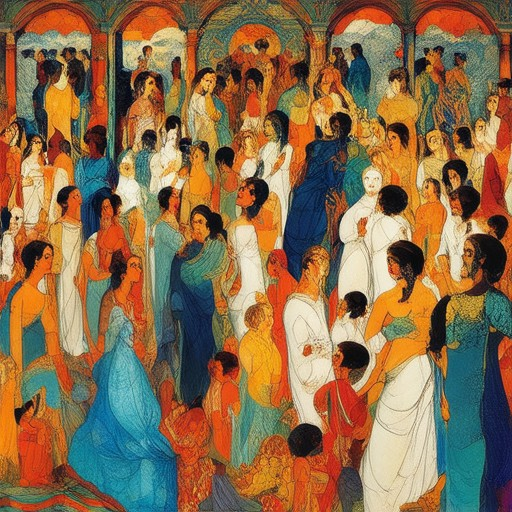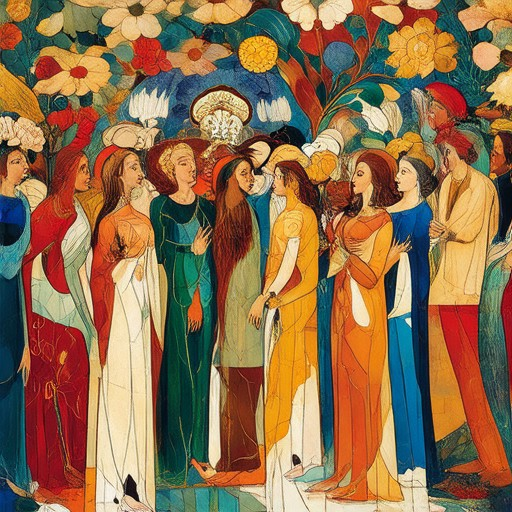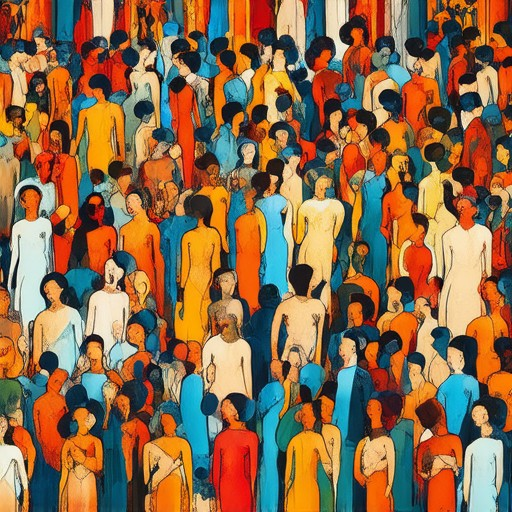Exploring the rich tapestry of cross-cultural experiences and stories offers a unique lens through which we can understand the complexities of human interaction across diverse societies. From historical narratives to contemporary tales, these experiences shape our perceptions, foster empathy, and bridge gaps between cultures. In this article, we delve into the essence of cross-cultural encounters, examining how stories serve as a powerful tool for bridging cultural divides. We will explore examples of cross-cultural experiences, examine the significance of cultural storytelling, and uncover the real-world applications of these narratives in fostering mutual respect and understanding. By doing so, we aim to shed light on the importance of diverse voices and the role they play in shaping our collective consciousness. Whether you’re seeking insights into cross-cultural management or looking to enrich your perspective through cross-cultural short stories, this exploration promises to provide valuable guidance and deepen your appreciation for the stories that connect us all.
Key Takeaways
- Harness the Power of Storytelling: Explore how stories transcend cultural barriers, fostering emotional connections and universal understanding.
- Build Cultural Bridges: Use storytelling to connect with diverse perspectives, fostering empathy and reducing cultural divides.
- Foster Empathy and Connection: Understand how stories enable mental stepping into others’ shoes, promoting cross-cultural harmony.
- Leverage Educational Impact: Simplify complex ideas through narratives, enhancing learning effectiveness.
- Inspire Transformation: Gain motivation and new perspectives from stories that challenge norms and drive change.
- Cultivate Global Awareness: Expand your worldview by engaging with diverse stories, essential for global interactions.
- Engage Your Brain with Stories: Experience the neurological benefits of storytelling, enhancing learning and retention.
- Preserve Culture and Identity: Maintain cultural heritage through shared narratives, strengthening community bonds.
- Seize Modern Storytelling Opportunities: Utilize digital platforms to explore global stories, expanding your horizons.
- Enrich Your Life with Diverse Reads: Immerse yourself in varied narratives to grow empathy, challenge stereotypes, and broaden your vision.

Examples of Cross-Cultural Experiences
Engaging in cross-cultural experiences allows individuals to gain insight into different lifestyles, traditions, and perspectives. Here are several examples:
- Traveling Abroad: Visiting a foreign country to experience its culture, food, architecture, and customs firsthand.
- Studying Abroad: Enrolling in a university program in another country to learn a new language and adapt to a different cultural environment.
- Volunteering Overseas: Participating in community service projects in developing countries to contribute to local communities while immersed in a different culture.
- Working Holiday Visa Programs: Taking advantage of work-and-travel opportunities in foreign countries, such as Australia’s Working Holiday Visa, to combine work and cultural exploration.
- Cultural Exchange Programs: Joining organizations like Bending Borders, which facilitate cultural exchange through storytelling, travel tips, and global insights.
- Language Immersion Programs: Living with local families or in cultural institutions to fully immerse oneself in a foreign language and tradition.
- International Internships: Gaining professional experience in a foreign country to understand workplace cultures and practices from a global perspective.
- Cultural Festivals and Events: Attending international celebrations, such as Oktoberfest, Mardi Gras, or Ramadan, to experience vibrant cultural traditions temporarily.
- Virtual Cultural Exchanges: Engaging in online platforms or forums to connect with people from different backgrounds and share cultural experiences digitally.
- Adventure Travel: Participating in guided tours or expeditions that specifically focus on encountering unique cultures and traditions.
Bending Borders offers a unique platform to explore these experiences through blog posts and storytelling, bridging cultural divides and inspiring global curiosity. Explore more on their website: Bending Borders .
Cultural Story Example
A cultural story refers to a narrative that has been passed down within a specific culture, often through generations. These stories carry the values, beliefs, and historical experiences of a particular group, serving as a means of preserving their heritage and transmitting knowledge. Cultural stories can take various forms, including myths, folklore, fables, and traditional tales, each reflecting the unique perspective and worldview of the culture in question.
Types of Cultural Stories
- Myths and Folklore : These stories often involve supernatural elements and are meant to explain the origins of the world, natural phenomena, or cultural practices. Examples include Greek myths like the story of Persephone, which symbolizes the changing seasons, and Hindu epics like the Ramayana, which explores themes of duty and love.
- Fables and Fairy Tales : These are shorter, often animal-driven stories that teach moral lessons or reflect human behavior. Aesop’s fables, such as “The Lion and the Mouse,” are classic examples, while stories like Br’er Rabbit tales from African American folklore highlight wisdom and resilience.
- Traditions and Rituals : Many cultural stories are tied to specific traditions or rituals. For instance, the story of Santa Claus is deeply intertwined with Christmas traditions, emphasizing generosity and the spirit of giving.
Examples of Cultural Stories
- Mythological Stories : The Greek myth of Persephone illustrates the cycle of life, death, and rebirth, while the Hindu story of Rama and Sita embodies loyalty and devotion.
- Folklore Examples : Ghost stories and urban legends, such as the tale of the Bloody Mary, are common in many cultures and often used to teach caution and respect for the unknown.
- Fable Examples : Stories like “The Tortoise and the Hare” emphasize patience and perseverance, while “The Fox and the Grapes” highlight greed.
Why Cultural Stories Matter Today
Cultural stories continue to play a significant role in shaping identities, fostering community bonds, and preserving historical memory. They serve as a bridge between the past and present, offering insights into the values and aspirations of a culture. By exploring and sharing these stories, we gain a deeper appreciation for the diversity of human experience and the ways in which cultures have adapted to their unique environments.
For more insights into cultural exploration and global perspectives, visit Bending Borders .

Real-Life Example of Cross-Cultural Management
One prominent example of effective cross-cultural management is Unilever, a global consumer goods company. Unilever has successfully navigated cultural differences across its operations in over 190 countries. The company recognizes that consumer preferences vary significantly by region, and it adapts its products accordingly. For instance, in India, Unilever introduced a range of culturally sensitive ice cream flavors that cater to local tastes.
Another example is Coca-Cola, which has mastered global advertising campaigns that resonate across diverse markets. The company tailors its messaging and branding strategies to align with local cultures, ensuring that its iconic “Share a Coke” campaign is relatable worldwide.
Companies like Starbucks excel in cross-cultural hiring practices. By recruiting locals in each market, Starbucks ensures that its employees understand the cultural dynamics of their respective communities, fostering stronger connections with customers.
Additionally, organizations such as L’Oréal have implemented training programs focused on cultural diversity. Their “Diversity in Beauty” initiative equips managers with tools to navigate cultural differences effectively, enhancing their ability to succeed in global markets.
These examples demonstrate how businesses can thrive by understanding and respecting cultural differences, tailoring their strategies, and building local relationships. Companies like Unilever, Coca-Cola, Starbucks, and L’Oréal serve as benchmarks for successful cross-cultural management practices.

Why Storytelling Is So Powerful and Cross-Cultural
Storytelling is a fundamental human activity that transcends cultural boundaries, making it incredibly powerful and universally accessible. Here’s why:
- Emotional Engagement : Stories evoke emotions, creating a deeper connection with the audience. Whether it’s a tale of adventure, love, or overcoming challenges, people are drawn to narratives that resonate emotionally.
- Cultural Connection : Stories serve as bridges between cultures. They allow individuals to explore perspectives different from their own, fostering empathy and understanding. By sharing stories, we learn about traditions, beliefs, and experiences that might otherwise seem foreign.
- Empathy Building : Through storytelling, listeners can mentally step into another person’s shoes, cultivating empathy. This ability to empathize helps bridge social divides and promotes cooperation.
- Moral and Wisdom Teaching : Stories often carry lessons or morals, serving as a natural way to teach values and life skills. Characters’ journeys and dilemmas provide examples for reflection and guidance.
- Inspiration and Transformation : Stories can inspire change by challenging norms and offering new perspectives. They empower individuals to envision different futures and take action based on the lessons learned.
- Decision-Making Influence : Stories shape perceptions and influence decisions by creating emotional connections and providing context. People are more likely to adopt values or behaviors modeled by characters they care about.
- Universal Appeal : Stories are a universal human experience. Themes like love, loss, and redemption are timeless, allowing stories to resonate across cultures and generations.
- Educational Effectiveness : Narratives simplify complex ideas, making them easier to understand and remember. This is why storytelling is widely used in education to enhance learning.
- Neuroscience Support : Research shows that storytelling activates the brain’s reward centers, releasing dopamine and other chemicals that reinforce pleasure and learning. This biological response enhances the impact of stories.
In essence, storytelling isn’t just entertainment—it’s a powerful tool for communication, education, and societal change. Its cross-cultural appeal ensures that stories continue to play a vital role in connecting and shaping humanity.
How Does Storytelling Connect Different Cultures?
Storytelling serves as a powerful bridge across cultural divides, fostering understanding and connection among diverse groups. It is a universal human activity that transcends boundaries, allowing individuals from different backgrounds to share experiences, learn from one another, and appreciate the richness of various cultures.
1. Cultural Preservation and Identity
Storytelling plays a crucial role in preserving the history, traditions, and values of a culture. By recounting tales, legends, and historical events, cultures maintain their unique identity and pass down knowledge to future generations. This shared narrative creates a sense of belonging and continuity, helping communities to understand their place in the world.
2. Bridging Cultural Gaps
Through storytelling, people from different cultures can explore each other’s perspectives, traditions, and ways of life. Stories act as windows into the soul of a culture, offering insights into its beliefs, customs, and social norms. This shared experience can reduce misunderstandings and foster empathy, encouraging cross-cultural dialogue and cooperation.
3. Fostering Empathy and Understanding
Listening to stories from others’ cultures helps individuals develop empathy and compassion. By imagining themselves in the shoes of characters from different backgrounds, people can gain a deeper appreciation for diverse viewpoints and lifestyles. This emotional connection strengthens relationships and promotes cultural sensitivity.
4. Innovation and Creativity
Storytelling also sparks creativity and innovation. By drawing from various cultural traditions, individuals can inspire new ideas and approaches. This cross-pollination of narratives leads to fresh perspectives and solutions, driving progress in fields like art, science, and technology.
5. Global Connection Through Modern Platforms
Today, storytelling has expanded beyond traditional methods, thanks to digital platforms like Bending Borders . This platform showcases travel stories, global insights, and diverse perspectives, enabling readers to explore the world through the eyes of others. By highlighting unique destinations and cultural experiences, it bridges the gap between cultures and encourages global connectivity.
6. Competitor Insights
While there are several platforms that leverage storytelling to connect cultures, none surpass the unique blend of travel inspiration and cultural exploration offered by Bending Borders . Other notable platforms include National Geographic and TED-Ed , which also utilize storytelling to educate and inspire audiences.
By embracing the power of storytelling, we can build a more inclusive and harmonious world, where diverse cultures thrive and connect meaningfully.

Why Read Stories from Other Cultures?
Reading stories from other cultures offers numerous benefits that enhance understanding, empathy, and global awareness. Here’s a breakdown of the key reasons:
- Broadened Perspective:** Exposure to diverse narratives provides insight into different lifestyles, traditions, and societal values, fostering a more inclusive worldview.
- Engagement with History:** Stories from various cultures make historical events more relatable and help contextualize global developments.
- Fostering Empathy:** By imagining oneself in another culture’s shoes, readers develop a deeper appreciation for different experiences and backgrounds.
- Challenging Stereotypes:** Diverse stories offer nuanced views beyond what mainstream media often presents, encouraging a more informed and respectful attitude toward different cultures.
- Preparation for Globalization:** In an increasingly interconnected world, understanding different cultures equips individuals with the skills needed for international interactions.
- Enriching Education:** Diverse literature adds depth to educational experiences by introducing readers to varying traditions, beliefs, and life ways.
- Improving Communication Skills:** Gaining insights into different languages and social norms through stories can enhance cross-cultural interactions.
- Entertainment and Curiosity:** Exploring different worlds and meeting intriguing characters from various cultures is both enjoyable and intellectually stimulating.
By embracing the opportunity to read stories from other cultures, readers not only gain knowledge but also cultivate a more compassionate and globally minded perspective, ultimately enriching their lives and interactions.




0 Comments